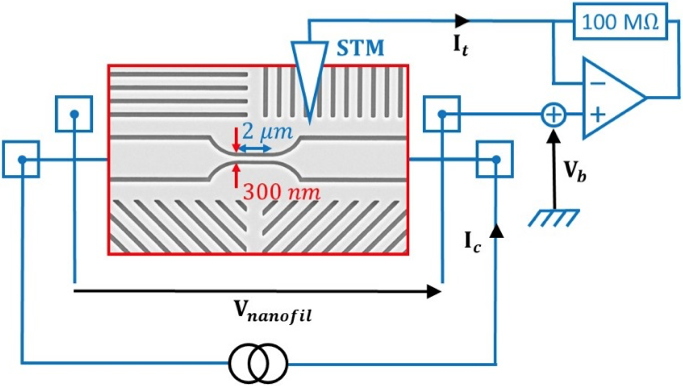In the ground state of a superconductor, electrons pair up to form so-called Cooper pairs. The temperature, a magnetic field, an electric current or an incident photon can break these pairs to restore single electrons also called quasi-particles. The presence of quasi-particles is therefore the sign of a weakening of superconducting properties, which can harm the proper functioning of superconducting circuits such as Qbits or, on the contrary, be used to make photon detectors.

Sketch of the experimental set-up: The nanowire is in the center of the image (red box). The tip of the STM (blue triangle) is used to inject electrons without contact into the nanowire by tunnel effect. The critical current of the nanowire is detected simultaneously.
Researchers at IRIG have studied the dynamics of quasiparticles using a scanning tunneling microscope (STM) operating at very low temperature near absolut zero (0.050 K). The STM makes it possible to locally inject electrons into a device by controlling both their energy by the electrical voltage, and the flux of injection by the tunneling current. Each injected electron then transfers its energy to the superconductor either by Coulomb interaction with the Cooper pairs, or via a phonon, i.e. a vibration of the atomic lattice. Each broken Cooper pair thus releases two very energetic quasi-particles which will in turn break other Cooper pairs. This cascade leads to the formation of a cloud of quasi-particles, thus creating a hot spot which can limit the critical current that a superconducting device is able to transport by superconductivity.
The scientists studied the injection of quasi-particles into a niobium nanowire 300 nm wide and 2 µm long. They simultaneously measured the critical current of about a hundred micro-amperes that could have been greatly weakened by the tunneling current a million times weaker. The attenuation is proportional to the product current multiplied by the voltage. It is therefore mainly due to a heating effect well described by a thermal model.
Moreover, by examining small deviations from the thermal model measured for different values of the tunneling current, we were able to model the dynamics of formation of the cloud of quasi-particles and determine a relaxation time of their energy of the order of 40 ps. This information is fundamental for optimizing the performance of photon detectors or protecting Qbits from quasiparticle poisoning.
Measurement of the critical current as a function of the injection voltage for different tunnel currents. The dotted horizontal line indicates the value of the critical current without quasi-particles injected.